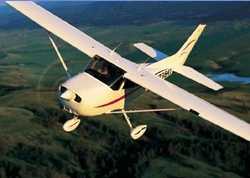No Fatalities When Student Pilot Reported Airspeed Indicator
Problem, Overshot Runway On Landing
 The student pilot flying a Cessna 172 did the right thing when
he requested a return to Santa Monica airport after reporting an
airspeed indicator malfunction, but was unable to execute a
successful go-around when he ran out of runway after flying a
traffic pattern that was too tight. Fortunately, no one was fatally
injured in the accident, but the accident broke the pilot's leg,
and two people painting a house sustained minor injuries when the
plane went down.
The student pilot flying a Cessna 172 did the right thing when
he requested a return to Santa Monica airport after reporting an
airspeed indicator malfunction, but was unable to execute a
successful go-around when he ran out of runway after flying a
traffic pattern that was too tight. Fortunately, no one was fatally
injured in the accident, but the accident broke the pilot's leg,
and two people painting a house sustained minor injuries when the
plane went down.
NTSB Identification: WPR11FA415
14 CFR Part 91: General Aviation
Accident occurred Monday, August 29, 2011 in Santa Monica, CA
Aircraft: CESSNA 172M, registration: N5155Q
Injuries: 1 Serious,2 Minor.
This is preliminary information, subject to change, and may
contain errors. Any errors in this report will be corrected when
the final report has been completed.
On August 29, 2011, about 1427 Pacific daylight time, a Cessna
172M, N5155Q, was substantially damaged when it impacted a tree and
collided into a wall and the side of a private residence after a
go-around from the Santa Monica Municipal Airport (SMO), Santa
Monica, California. The student pilot, the sole occupant, was
seriously injured, and two of the three painters who were working
outside the home sustained minor injuries. The airplane was
registered to Planeminder LLC and operated by Justice Aviation
under the provisions of 14 Code of Federal Regulations Part 91 as a
planned solo flight to Santa Barbara, California. Visual
meteorological conditions prevailed, and no flight plan was filed.
The airplane departed SMO about 1423.
According to the student pilot, following completion of the
pretakeoff checks, the flight was cleared for takeoff. A few
seconds after liftoff the student observed that the airspeed
indicator was malfunctioning. The indicator's needle suddenly
increased and then decreased until reaching zero miles per hour
(mph). The student pilot informed the SMO air traffic controller
that he had experienced an airspeed indicator failure and wanted to
return for landing. About 1 minute later the controller cleared the
pilot to land on runway 21, from which he had just departed.
File Photo

The student pilot proceeded to climb the airplane into the
traffic pattern and kept the airplane closer to the runway, which
resulted in it being higher than normal on short final approach and
crossing over the landing threshold. As the airplane approached the
last 1/4 of the runway, it was about 30 to 40 feet above the
runway's surface when the pilot was directed to go around by the
SMO controller.
The student pilot reported that he acknowledged the air traffic
instruction, raised the wing flaps, and pushed the engine's
throttle full forward. Thereafter, the student pilot observed power
lines in front of the airplane, and he maneuvered right and left to
avoid them.
The airplane initially collided with a tree located about 900
feet west of the departure end of runway 21. The distance between
the impacted tree top and the main wreckage, located partially on
top of a block wall, is about 85 feet. The engine and instrument
panel were displaced in upward and aft directions.
The airplane has been recovered from the accident site and
retained for further examination of the airframe structure and
engine.
 Bolen Gives Congress a Rare Thumbs-Up
Bolen Gives Congress a Rare Thumbs-Up The SportPlane Resource Guide RETURNS!!!!
The SportPlane Resource Guide RETURNS!!!! Buying Sprees Continue: Textron eAviation Takes On Amazilia Aerospace
Buying Sprees Continue: Textron eAviation Takes On Amazilia Aerospace Hawker 4000 Bizjets Gain Nav System, Data Link STC
Hawker 4000 Bizjets Gain Nav System, Data Link STC Echodyne Gets BVLOS Waiver for AiRanger Aircraft
Echodyne Gets BVLOS Waiver for AiRanger Aircraft




